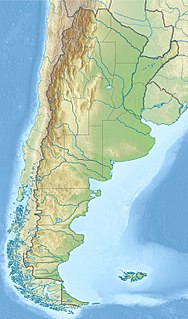| Obere Bunte Mergel Stratigraphic range: Upper Triassic | |
|---|---|
| Type | Geological formation |
| Location | |
| Country | |
The Obere Bunte Mergel is a geological formation in Switzerland. It dates back to the late Norian. [1]
| Obere Bunte Mergel Stratigraphic range: Upper Triassic | |
|---|---|
| Type | Geological formation |
| Location | |
| Country | |
The Obere Bunte Mergel is a geological formation in Switzerland. It dates back to the late Norian. [1]
| Dinosaurs of the Obere Bunte Mergel | ||||||
|---|---|---|---|---|---|---|
| Genus | Species | Location | Stratigraphic position | Abundance | Notes | Images |
cf. Plateosaurus longiceps [1] |  | |||||
Suborder:
| Includes "cf. Liliensternus sp." [1] | |||||

The Lance (Creek) Formation is a division of Late Cretaceous rocks in the western United States. Named after Lance Creek, Wyoming, the microvertebrate fossils and dinosaurs represent important components of the latest Mesozoic vertebrate faunas. The Lance Formation is Late Maastrichtian in age, and shares much fauna with the Hell Creek Formation of Montana and North Dakota, the Frenchman Formation of southwest Saskatchewan, and the lower part of the Scollard Formation of Alberta.
The Maleri Formation is a sedimentary rock formation found in Andhra Pradesh, India. It is of Norian age, and is notable for its fossils of early dinosaurs, including the basal saurischian Alwalkeria.

The Lameta Formation, also known as the Intertrappean Beds is a sedimentary rock formation found in Madhya Pradesh, Gujarat, and Maharashtra, India. It is of Maastrichtian age, and is notable for its dinosaur fossils. Many dubious names have been created for isolated bones, but several genera of dinosaurs from these rocks are well-supported, including the titanosaur sauropod Isisaurus and the abelisaurs Indosaurus, Indosuchus, Laevisuchus, and Rajasaurus. As well as mammals
Argiles et Grès à Reptiles Formation is a French geologic formation in the département of Var preserving the remains of several types of dinosaurs and other extinct organisms.
The Twin Mountains Formation, also known as the Twin Mountain Formation, is a sedimentary rock formation, within the Trinity Group, found in Texas of the United States of America. It is a terrestrial formation of Aptian age, and is notable for its dinosaur fossils. Dinosaurs from this formation include the large theropod Acrocanthosaurus, the sauropod Sauroposeidon, as well as the ornithopods Tenontosaurus and Convolosaurus. It is the lowermost unit of the lower Cretaceous, lying unconformably on Carboniferous strata. It is overlain by the Glen Rose Formation. It is the lateral equivalent of the lower part of the Antlers Formation.
The Löwenstein Formation is a lithostratigraphic formation of the Keuper in Germany. It is underlain by the Mainhardt Formation and overlain by the Trossingen Formation. It dates back to the middle Norian.
The Trossingen Formation, formerly the Knollenmergel, is a geological formation in Germany. It dates back to the late Norian.
The Alcobaça Formation is a geological formation in Portugal. It dates back to the Oxfordian stage of the Late Jurassic. It is an important source of information on the diversity of Late Jurassic mammals. Many of the fossils were collected from the now disused and flooded Camadas de Guimarota coal mine.
The Camadas de Guimarota, simply Guimarota, or Camadas de Alcobaça is a disused coal mine near the city of Leiria in central Portugal. The mine is within layers of the Alcobaça Formation, Kimmeridgian age of the Late Jurassic period, it contains a diverse array of fossil animals and plants, including dinosaurs and mammals.
The EL Castellar Formation is a geological formation in La Rioja and Teruel, Spain whose strata date back to the possibly the Valanginian to the Barremian stages of the Early Cretaceous. Dinosaur remains are among the fossils that have been recovered from the formation.
The Ashville Formation is a geological formation in Saskatchewan and Manitoba whose strata date back to the Late Cretaceous. Dinosaur remains are among the fossils that have been recovered from the formation.

The Aguja Formation is a geological formation in North America, exposed in Texas, United States and Chihuahua and Coahuila in Mexico, whose strata date back to the Late Cretaceous. Dinosaur remains are among the fossils that have been recovered from the formation.
La Bocana Roja Formation is a geological formation in Baja California, Mexico whose strata date back to the Late Cretaceous. Dinosaur remains are among the fossils that have been recovered from the formation.
The Arén Formation or Arén Sandstone Formation is a geological formation in Arén, Spain whose strata date back to the Late Cretaceous. Dinosaur remains are among the fossils that have been recovered from the formation.
The Trichinopoly Group is a geological formation in India whose strata date back to the Late Cretaceous. It lies between the Ootatoor and Ariyalur groups. It is broad in its southern extremity but thins as it gradually proceeds northwards as it ultimately meets the Ariyalur group. Dinosaur remains are among the fossils that have been recovered from the formation.
The Viñita Formation is a geological formation in Coquimbo, Chile, whose strata date back to the Late Cretaceous. Dinosaur remains are among the fossils that have been recovered from the formation.

The Lecho Formation is a geological formation in the Salta Basin of the provinces Jujuy and Salta of northwestern Argentina. Its strata date back to the Early Maastrichtian, and is a unit of the Salta Group. The fine-grained bioturbated sandstones of the formation were deposited in a fluvial to lacustrine coastal plain environment.

The Los Alamitos Formation is a geological formation of the North Patagonian Massif in Rio Negro Province, northwestern Patagonia, Argentina, whose strata date back to the Late Cretaceous. Dinosaur remains are among the fossils that have been recovered from the formation.